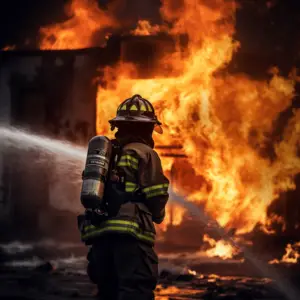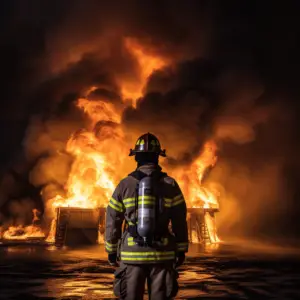Table of Contents
Introduction to Fire Safety Measures
Fire Safety Measures, is key for avoiding and minimizing fire risk in various settings. Preventative actions and emergency procedures protect lives and property. Adhering to fire codes and regulations create structures that are more resistant to fires, and provide safe escape routes.
Education and training on fire safety practices inform people how to identify fire hazards, use firefighting equipment, and evacuate safely. These drills simulate real-life scenarios, improving preparedness. Early warning systems like smoke detectors, heat sensors, and sprinkler systems alert occupants or authorities and reduce potential damage.
Fire safety measures apply to buildings, transportation vehicles, industrial facilities, and outdoor areas, requiring specific prevention strategies and plans. The NFPA reports U.S. fire departments respond to a home fire every 93 seconds, stressing the need for fire safety awareness.
Implementing comprehensive fire safety measures is essential for protecting lives and property from fire destruction. Combining preventive actions with effective emergency response procedures creates a safer environment for everyone.
Preventive Measures
To stop fires & stay safe, you should:
- Put smoke detectors in each room of the house.
- Check & replace batteries in smoke detectors often.
- Keep flammable items away from heat sources.
- Keep electrical wiring & appliances working properly.
- Have a plan with family in case of emergency.
Plus, teach kids fire safety without using scary tactics.
Pro Tip: Do regular fire drills at home to make sure everyone knows what to do.
Fire detectors are no fun, but they save lives!
Fire Detection and Warning
Detection systems are key for early fire identification and prevention. They provide the first layer of defense when it comes to fire safety, warning people to evacuate in time.
- Smoke detectors are an integral part of fire detection systems. They swiftly detect smoke particles in the air and emit a loud sound, alerting people.
- Heat detectors are useful in areas where smoke can’t be avoided or is inconvenient, such as kitchens or laboratories. They set off the alarm when temperatures rapidly increase.
- Sprinkler systems are connected with fire alarms to add extra protection. These automatic devices automatically switch on when they detect high temperatures or flames, helping to reduce fire damage.
Having an efficient fire detection and warning system means you can quickly respond to possible dangers. This helps to lower the chance of injuries, fatalities, and property damage.
Take a recent commercial building incident as an example. The cutting-edge fire detection technology in place quickly alerted the people when a small electrical malfunction caused a nearby flammable material to catch fire. Thanks to the alarm, everyone had the chance to evacuate safely before the situation got worse.
Don’t forget, investing in reliable fire detection and warning systems could mean the difference between life and death in an emergency. Stay alert and prioritize safety with the help of alarm systems. Be aware that when responding to and controlling fires, speed is of the essence. Don’t wait for your home to become the next hot spot!
Fire Response and Control
Table:
| Strategy | Description |
|---|---|
| Fire Prevention | Reducing the risk of fire occurrence |
| Fire Detection | Utilizing systems to identify a fire |
| Alarm Systems | Installing alarms to alert occupants in case of a fire |
| Evacuation Plan | Developing a plan for safely evacuating people from the site |
| Fire Suppression | Employing methods to extinguish or control the spread of fire |
In addition to these measures, it’s essential to consider other factors for fire response and control. This includes:
- Conducting regular fire drills
- Ensuring personnel are trained on emergency procedures
- Inspecting & maintaining firefighting equipment
- Staying updated with evolving fire safety regulations.
To protect lives and property, it’s important to prioritize fire safety. Take proactive steps such as:
- Installing smoke detectors
- Practicing good housekeeping
- Having fire extinguishers
- Promoting safety awareness.
Take action now! Prioritize fire safety by:
- Reviewing existing emergency plans
- Conducting regular inspections
- Providing training sessions
- Implementing preventive measures.
Remember: every second counts when it comes to fires. And don’t forget to check if your eyebrows made it out alive too.
Post-Fire Measures
Let’s take a look at the essential post-fire measures. The table below outlines their purpose:
| Measure | Purpose |
|---|---|
| Assessment of Damage | Evaluate the extent of fire damage |
| Structural Stability Check | Determine building stability |
| Salvaging Valuables | Save valuable items from the fire-damaged area |
| Cleaning and Debris Removal | Clear out debris and clean any residue |
| Restoration and Reconstruction | Rehabilitate and rebuild damaged structures |
| Review Fire Safety Systems | Assess fire safety systems |
These measures should also prioritize emotional support. People dealing with such events need counseling and resources for recovery.
The Great Fire of London in 1666 showed the importance of prompt firefighting and proper post-fire actions.
Post-Fire Measures include assessing damage, ensuring structural integrity, salvaging valuables, cleaning up debris, restoring what was lost, reviewing fire safety systems, and offering emotional support. They help minimize harm and foster effective recovery.
Be sure to be prepared – fire safety isn’t just hot, it’s smokin’ hot!
Conclusion and Importance of Fire Safety Measures
Fire safety is vitally important: to protect lives, property, and the environment from fires. Fire alarms and extinguishers, evacuation plans, fire drills, proper storage of flammable materials are all necessary measures.
Other details must not be overlooked. Clear exit paths, emergency lighting, electrical inspections, and fire-resistant building materials help reduce fire risks.
Let’s reflect on a true story. In an office building, an electrical fault caused a small fire. Fortunately, due to smoke detectors and quick evacuation, all personnel made it out safe. This serves as a reminder that fire safety measures do work in emergencies.


